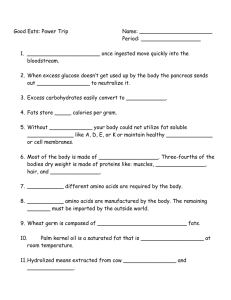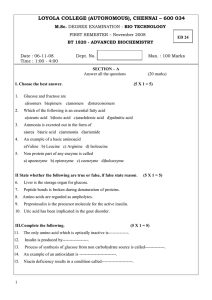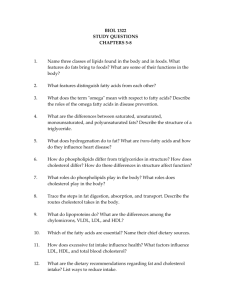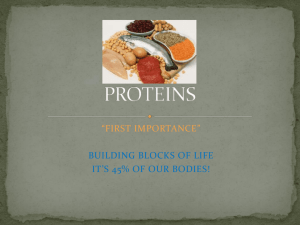Nutrition 244 Exam 2 SG
advertisement
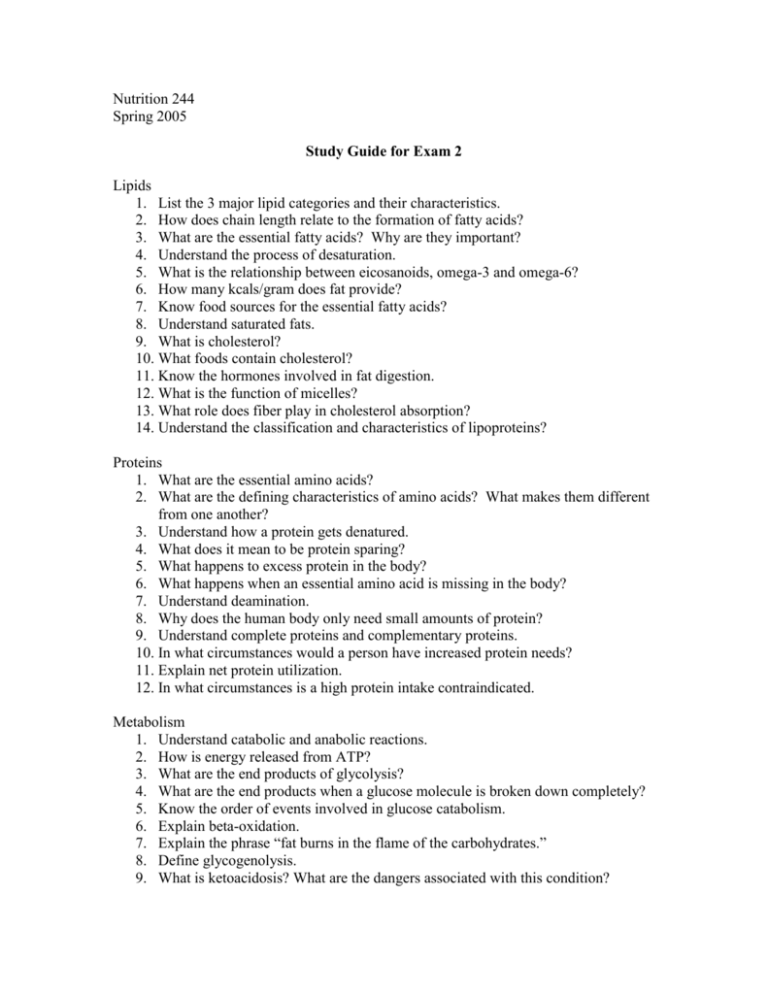
Nutrition 244 Spring 2005 Study Guide for Exam 2 Lipids 1. List the 3 major lipid categories and their characteristics. 2. How does chain length relate to the formation of fatty acids? 3. What are the essential fatty acids? Why are they important? 4. Understand the process of desaturation. 5. What is the relationship between eicosanoids, omega-3 and omega-6? 6. How many kcals/gram does fat provide? 7. Know food sources for the essential fatty acids? 8. Understand saturated fats. 9. What is cholesterol? 10. What foods contain cholesterol? 11. Know the hormones involved in fat digestion. 12. What is the function of micelles? 13. What role does fiber play in cholesterol absorption? 14. Understand the classification and characteristics of lipoproteins? Proteins 1. What are the essential amino acids? 2. What are the defining characteristics of amino acids? What makes them different from one another? 3. Understand how a protein gets denatured. 4. What does it mean to be protein sparing? 5. What happens to excess protein in the body? 6. What happens when an essential amino acid is missing in the body? 7. Understand deamination. 8. Why does the human body only need small amounts of protein? 9. Understand complete proteins and complementary proteins. 10. In what circumstances would a person have increased protein needs? 11. Explain net protein utilization. 12. In what circumstances is a high protein intake contraindicated. Metabolism 1. Understand catabolic and anabolic reactions. 2. How is energy released from ATP? 3. What are the end products of glycolysis? 4. What are the end products when a glucose molecule is broken down completely? 5. Know the order of events involved in glucose catabolism. 6. Explain beta-oxidation. 7. Explain the phrase “fat burns in the flame of the carbohydrates.” 8. Define glycogenolysis. 9. What is ketoacidosis? What are the dangers associated with this condition? 10. During starvation, how does the body utilize glucose? 11. What micronutrient is associated with NAD? 12. What are the end products when amino acids are broken down? Energy Balance, Body Composition and Weight Management 1. Understand energy balance. 2. Understand internal cues (hunger, satiation and satiety). 3. What is the difference between hunger and appetite? 4. What types of food encourage overeating and why? 5. Understand basal or resting energy expenditure. 6. What is calorimetry? 7. What is considered the gold standard for calorimetry? 8. Know the difference between gynoid obesity and android obesity. What are the risk factors? 9. What factors have contributed to the obesity epidemic in the United States? 10. Know the theories associated with weight regulation. 11. What factors increase a person’s risk for becoming obese? 12. What is the mechanism that causes weight loss in a high-protein, low carbohydrate diet? 13. Understand over the counter weight loss drugs and dietary supplements.
